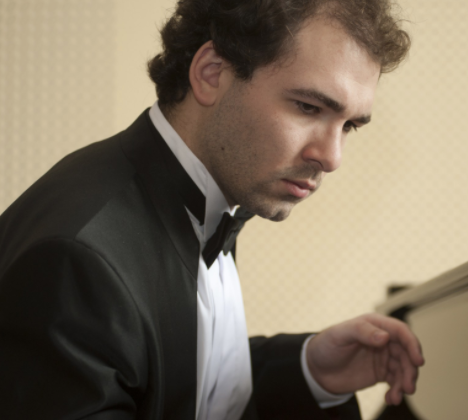Mateusz Borowiak, piano
Merkin Concert Hall at Kaufman Center, New York, NY
Sunday, November 12, 2017, 8PM
Mateusz Borowiak’s series of three recitals came to a close on Sunday, with perhaps his most magisterial display of pianistic grandeur. It also gave me, now having heard all six of Louis Pelosi’s piano sonatas, a clear favorite. This is terrible to decide, a sort of musical “Sophie’s choice,” but his Sonata No. 3 in B-flat gets my vote. The crystalline piano sonorities juxtaposed with the characteristically dense ones, the overall playfulness of some of the material, and a certain resemblance (spiritual only, not imitative) to Bartók’s Piano Concerto No. 3 (slow movement) in Pelosi’s slow movement, all endeared it to me.
Over the course of the three recitals, I heard numerous audience members grumbling that they couldn’t “follow” the structure, but make no mistake about it, Pelosi is a firm structuralist. It does take a certain fierce concentration, for it is more about densities, textures, and motives, things that the average listener has lost touch with identifying (a fault of society’s lack of music education, and the decline of home music making). I think someone clever could fashion two sonatas for every one of Pelosi’s, simply by removing about half the material and placing it on another manuscript page, but that is not for me to decide.
The Sonata No. 2 in A, a much fiercer, grimmer work, opened the recital, and it was presented perfectly by Mr. Borowiak, certainly Pelosi’s most capable advocate. Its principle of continuous evolving variation was clear, and there was even a Brahms-like consoling moment in the slow section.
After intermission, Mr. Borowiak presented the second set (Op. 39) of Rachmaninoff’s Études-Tableaux, which are programmatic, though the composer was often secretive about revealing specific images. They were composed near the end of 1916 to the beginning of 1917, just before the composer was driven from his native land, sorrowfully, by the turmoil of revolution. In fact, the famous E-flat minor etude (No. 5), the final one written, was completed just four days before the premiere of the set by Rachmaninoff himself. For who else could possibly have played these uncompromising, complicated studies?
Of course, today all young pianists grow up with these and other difficult repertoire firmly in their lesson plans, especially if they are serious about a career. In fact, through the course of Mr. Borowiak’s survey, I had to ponder how many physiological limitations have been conquered, how the landscape of what’s “possible” has evolved, even in my time, let alone since 1900.
Mr. Borowiak favored a “big-boned” approach to the Rachmaninoff, with gigantic sonority, big arching structure, clear voicing, and wonderful elasticity. Remember, Stravinsky referred to Rachmaninoff as a “six-and- a- half -foot scowl,” and it was mainly this person we hear in these distinctly anxiety-ridden works. For me, the stand-outs were No. 2 (“the sea and the seagull”), No. 5, No. 7 (“funeral march”), and No. 8, but they were all beautifully played, with complete fearless mastery. Mr. Borowiak organized their complexity with such assurance that the set sounded more coherent than I can recall from any recent artist.
After his customary tumultuous ovation, Mr. Borowiak, in a gesture of extreme modesty and renunciation, didn’t play an encore, though it was richly deserved (nor had he on any of the recitals).
When was the last time you saw the word aposiopesis in a program note? Yes, I had to look it up. Congratulations to you, Mateusz, and may you grace our shores again with more intelligent programming.

